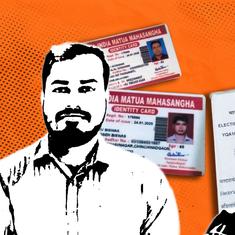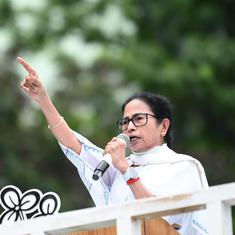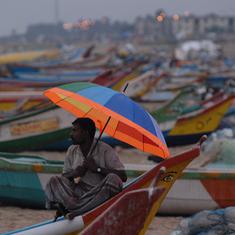Kerala, and adjoining districts of Karnataka and Tamil Nadu, are reeling under some of the worst floods in nearly a century, with lakhs of people affected. Thirty three people died due to rain-related incidents on just Saturday alone, and the total number of rain-related deaths in Kerala since May 29 is now at 357. Hundreds of thousands of people have been rescued and placed in relief camps across the three states, with Kerala facing the brunt of the deluge. You can follow all the latest updates on the crisis here, but below is a quick primer on the situation, what things look like on the ground, and what you can do to help.
Why is this happening?
This simple answer is rain. Lots of it. In the week ending August 15, Kerala received 3 times the amount of rain it normally gets at this time of the year. Two districts alone, Idukki and Wayanad, received almost as much rain as the entire state expects to get during this time. No wonder then that the scale of the problem seems massive. And it isn’t limited to just Kerala. Neighbouring states Karnataka and Tamil Nadu have also seen heavy rains in adjoining districts, though, as Mridula Chari and Anand Katakam point out, the monsoons have been very erratic.

The more complicated answer might take you to policy decisions, which are only now being examined in light of the devastation caused by the floods. Environmentalists have pointed out that the Kerala government’s approach to environmentally sensitive zones, particularly in allowing quarrying and indiscriminate building, has made things worse, particularly in creating the conditions for landslides.
Mridula Chari reports on one specific example. The Kochi Airport, which has been shut for an unprecedented 11 days, was built just 400 metres from the Periyar river and after realigning and narrowing a creek. As one activist put it, “if you take a flood plain, there is every chance of a flood, even after you reclaim it.”
What do things look like on the ground?
Jacob Cherian and Sruthi Sahsranamam reported on August 17 about the situation in Kozhikode, where the floodwaters entered people’s houses and landslides took out portions of highways. Residents were helping each other out, but were also worrying about how soon food and other provisions will start to run out.
On August 18, S Senthalir reported from the Erode and Nammakal in Tamil Nadu, where the Cauvery is flooding and submerging the houses of those, particularly labourers, who had built them on the banks of the river. Just four kilometres away from the river, farmers are, however, complaining about the lack of irrigation water, revealing the complexity – and institutional failure – of river management in the area.
T Ameerudheen reported on how the deluge has left people without fuel and medicine. More than 400 petrol pumps across many districts are submerged, as well as over 1,500 pharmacies, and restoring all of those could take a long time. Sruthisagar Yamunan reported on how damage to cell phone towers and power shortages has left large areas without any phone connectivity, which will take at least three days to rectify, if not more.
The next day, T Ameerudheen reported on conditions in Chalakkudy, one of the worst-hit districts in Kerala. The waters are now beginning to recede, but as that happens, the scale of the disaster is beginning to be apparent: Houses are damaged, residents are struggling to contact their relatives, and everyone is concerned about the potential for disease to break out.
Videos offer a better sense of just how bad things are. In Kodagu, Karnataka, a two-storeyed building went sliding down a hill after incessant rains. In Kerala, a man took a video while standing in water that was neck-deep inside his own house. Through all of this, journalists have also been heading into the flood-affected regions to tell stories of what residents are going through and what still needs to be done.

What about the rescue efforts?
Lakhs of people have been rescued and placed in relief camps across the three states. Videos show the Navy having to airlift people to security. But the challenge is still immense. Members of Parliament from Kerala told Sruthisagar Yamunan and Nayantara Narayanan that much more help is needed: whether that comes in the form of choppers, boats, medicines or just generally more support from the Central government.
Kerala Chief Minister Pinarayi Vijayan had put the damage at Rs 19,512 crore and asked the Centre for immediate relief of Rs 2,000 crore. Prime Minister Narendra Modi, after conducting an aerial survey, announced a relief package of Rs 500 crore on Saturday.
Meanwhile, the Gulf states of UAE, Oman and Qatar all announced that they would be sending money and aid to Kerala, with many residents of the state living in their countries. United Arab Emirates Prime Minister Sheikh Mohammed bin Rashid al Maktoum said his country had a “special responsibility” to help the state as its people had “always been and are still part of our success story”.
But the difficulty doesn’t end with simply rescuing lakhs of people. The task afterwards will be rebuilding and avoiding the outbreak of disease. Nayantara Narayanan wrote about what the Kerala health officials are doing to prepare for in the aftermath of the disaster, particularly in educating those in relief camps about how to prevent disease outbreaks.
What can I do to help?
While rescue and relief efforts continue, citizens have also taken to social media to help organise donations and coordinate some of the relief efforts. This list, compiled by The News Minute, is a full list of how you can contribute to the efforts, whether you are in India or abroad.










